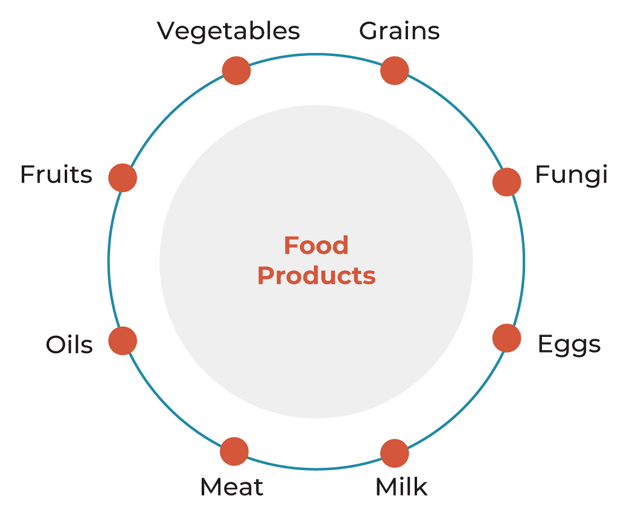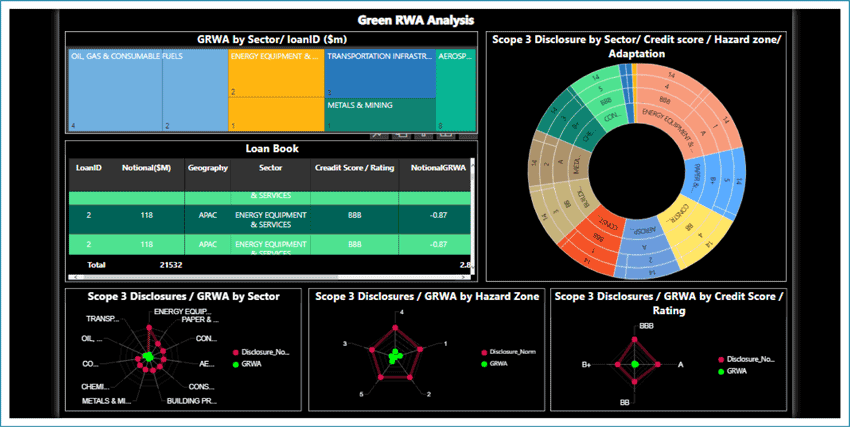The global food industry and climate change are highly interconnected. Banks financing agriculture need to understand this relationship and the risks it creates.
This paper highlights these two important aspects of modern life, with a focus on sustainability within agricultural products and production. It also delves into externalities of the food industry with regard to climate change and finally, considers the physical and regulatory risks to the industry along with potential adaptations.
The global food industry is vast and not easy to define…
The global food industry is enormous and consists of multiple divisions. However, these can be grouped into:

All these groups are connected by:
- Transportation
- Storage
Each segment has specific characteristics and is affected by climate change differently. This report focuses exclusively on the sub-segment of Agricultural Production, which is defined as the practice of cultivating plants and livestock, and thereby the use of several resources. These resources include land, soil, fertilizer, animal feed, seed, water, labor, and energy to produce food products, fiber, fuel, and raw materials.
Food products are divided into:

In simple terms, this report is hyper-focused on that part of the food sector, which directly produces food.
Agriculture can be a major contributor to national wealth…
The importance of agriculture to a nation’s economy varies substantially, with the agricultural sector contributing as much as 60% of the GDP in some developing countries, with the average contribution being 4% in developed nations. Considering the EU and US specifically, according to the World Factbook, the agricultural sector contributed 1.6% and 0.9% respectively to regional GDP in 2019.
Agriculture is also a major contributor to climate change…
Climate change and agriculture are symbiotically related. On one hand, agriculture is very vulnerable to climate change because it transforms the manner in which agricultural production can operate. On the other hand, agricultural production is one of the key contributors to greenhouse gas emissions, thereby exacerbating climate change.
Climate factors that affect agriculture include:
- Change in rising temperatures
- Increase in extreme weather events
- Changing precipitation patterns
However, how farmers and agricultural products, are affected varies substantially depending on:
- Crops or farming products used
- Geographic location
- Regulatory environment
To generalize, crop yields in lower latitude regions are decreasing while those in higher latitudes are increasing because of climate change.
Agricultural production creates externalities…
Modern industrialized agriculture, with its often-occurring monocultures, is the reason for many externalities arising from how agricultural products are produced. The resources used for production very often have negative externalities.
For example, the use of nitrogen fertilizer increased significantly in the latter half of the 20th century to increase crop yields. Simultaneously, this has led to the pollution of water and oil.
Other externalities produced by agricultural production include:
- Environmental degradation such as biodiversity loss
- Desertification and soil degradation
- Water pollution
- Greenhouse Gases (GHGs)
These factors contribute directly or indirectly to climate change. Most notably are GHGs emitted by this sector. According to the Food and Agriculture Organization (FAO) of the UN, the overall food supply chain accounts for more than a third of global GHG emissions.
The combined environmental cost of food production amounts to an estimated 12 trillion USD per year. The FAO argues that it is crucial to reduce emissions within the global food system to achieve the global (agreed in Paris, 2015) climate goal. The figures vary, depending on the specific study and underlying definition of the food sector. However, the overall trend is that the food sector is one of the most significant global contributors to climate change. Likewise, the Intergovernmental Panel on Climate Change (IPCC) concludes that it is inevitable that the food system adopts measures to fight climate change by reducing GHGs.
According to figures from the 2019 International Plant Protection Convention (IPPC) report, 19-38% of GHGs can be attributed to agriculture. The report further calculates that 9-14% comes from crop and livestock activities. Livestock is a significant contributor to emissions worldwide due to it being a substantial source of methane emissions and by being a key driver of deforestation. Furthermore, 5-14% of GHGs come from land use, which includes deforestation.
The rest (5-10%) can be limited to supply chain activities.
These externalities circle back to create risks to agricultural production…
Potential risks to agricultural production can be divided into two types:
- Physical Risk and
- Regulatory Risk
While Physical Risk describes the ones posed by physical changes resulting from climate change that will threaten agricultural production, Regulatory Risk focuses on the dangers posed by potential future regulations that could significantly alter the production cost of agricultural goods.
Effective adaptation can mitigate vulnerabilities that the food system is exposed to due to climate change, both regulatory and physical.
Adapting to physical risks is non-optional…
Physical Risks are those that result from climate change such as extreme weather events, including droughts, floods, extreme precipitation, and wildfires. However, it also includes changing temperature and the way in which the physical environment is evolving. For example, the increasing average temperature may not allow the cultivation of certain crops in a region where they have been previously harvested.
Because agricultural production differs by crops and products, adaptation toward physical risk can be also very different. Considering New York State, suggested adaptations include:
- Increasing soil organic matter and erosion control
- Improved cropland graying land management
- Genetic improvements
Other adaptations include diversifying crop rotations to improve soil quality diversification through planting different plants, i.e., fewer monocultures. Furthermore, adaptation techniques may include integrated pest management systems, selective breeding to control and implement more efficient irrigation systems, and greater reliance on renewable energy.
Regulatory risks loom equally large…
The food industry is already highly regulated, with the goal being the protection of consumers by regulating food safety, food security, and animal well-being. For the US and EU, the regulatory institutions are the Food and Drug Administration (FDA) and European Food Safety Authority (EFSA). Even if regulation is currently limited mainly to food safety, it is likely that regulations, which specifically address negative externalities within the food sector will be implemented in future.
For example, the transition towards a sustainable food system is a core part of the EU’s Green Deal. Furthermore, the IPPC assumes that there will be adjustments in the regulation of the food system in future, to lower GHGs that the industry is producing, and thus be in line with the Paris Agreement. Several potential regulations could significantly impact the way the industry operates.
On the supply side, potential regulations include a reduction in methane emission and a ban on environmentally hazardous fertilizers. And on the demand side, there are regulations concerning reduction of food waste and taxes on meat consumption.
Financing agriculture must take these risks into account…
When banks provide financing for agricultural production, the externalities and risks within the industry must be accounted for when assessing the credit risk. Loss of productivity from physical climate impacts and loss of profitability from increased regulatory costs across the whole supply chain can both dramatically increase the credit of the borrowing food producer. Banks that ignore this, or fail to fully build it into their calculations may well suffer unexpected credit losses as a result, and consequently, be under-capitalized from a risk perspective.
GreenCap can help…
GreenCap is a turnkey ‘Risk as a Service’ (RaaS) solution that provides banks with tools to create and populate climate-based scenarios. These scenarios will reflect the impacts and costs of the IPCC pathways and regional plans.
The system provides loan by loan climate risk analysis, including potential increases in risk capital that should be expected per scenario, and the credit spread differential, in basis points that would be needed to justify that risk.

GreenCap takes hazard zones and transitional adaptations into account, resulting in a granular analysis that uses all available data to provide insights that can be put to immediate use within the bank.

